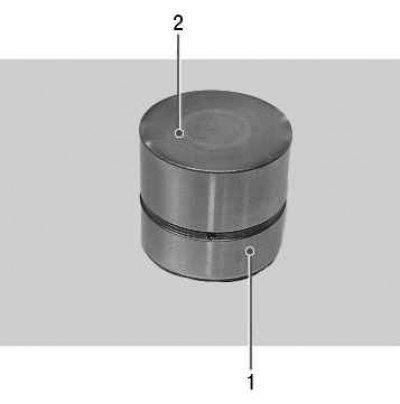
The hydraulic pushers of the VAZ-21126 engine, made in the form of cylindrical pushers located between the camshaft and valves, combine two functions: transferring force from the camshaft to the valves and eliminating gaps in their drive.
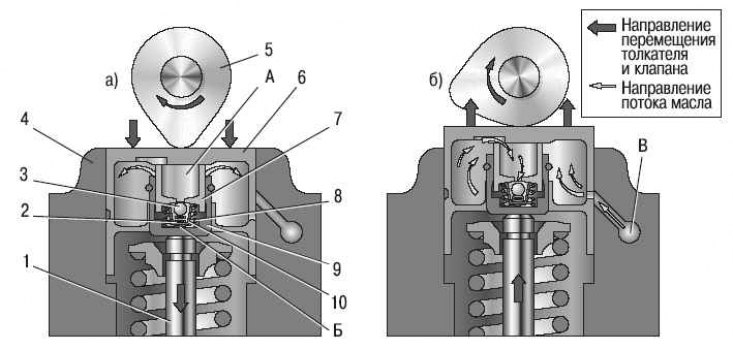
Pic. 5.8. The scheme of the hydraulic pusher in the valve mechanism of the VAZ-21126 engine: 1 - valve; 2 - check valve spring; 3 - check valve; 4 – a head of the block of cylinders; 5 - camshaft cam; 6 - pusher; 7 - plunger; 8 - plunger spring; 9 - sleeve; 10 - check valve body; A, B - cavities of the hydraulic pusher; B - oil channel
The operation of the hydraulic pusher is based on the principle of incompressibility of engine oil, which constantly fills the internal cavity of the hydraulic pusher during engine operation and moves its plunger when a gap appears in the valve drive. This ensures constant contact of the pusher with the camshaft cam without play. This eliminates the need for valve adjustment during maintenance. The principle of operation of the hydraulic pusher is shown in fig. 5.8. Oil under pressure necessary for the operation of the hydraulic pusher is supplied to the internal cavities A and B from channel C of the engine lubrication system through a side hole in the pusher 6, made in the annular groove of its cylindrical surface. When the valve is closed 1 pusher 6 (through plunger 7) and sleeve 9 by the expanding force of the spring 8 are pressed respectively to the cam 5 of the camshaft and the end of the valve stem. The pressure in cavities A and B is the same, the check valve 3 of the hydraulic pusher is pressed against the seat in the plunger 7 by the spring 2 - there are no gaps in the valve mechanism. When the camshaft rotates, the cam 5 runs on the pusher 6, moving it and the plunger 7 associated with it. sleeve 9 moves in one piece and opens valve 1. With further rotation of the camshaft, cam 5 reduces the pressure on the pusher 6 and the oil pressure in cavity B becomes lower than in cavity A. Check valve 3 opens and passes oil from cavity A connected to oil line of the engine, into cavity B. The pressure in cavity B increases, sleeve 9 and plunger 7, moving relative to each other, select the gap in the valve mechanism.
The pressure of the oil supplied to the hydraulic pushers is regulated by a valve installed in the cylinder head. Since, after the engine is stopped, oil drains from the channels leading from the oil pump into the oil sump, and the channels for supplying oil to the hydraulic pushers remain filled, after starting the engine, air locks may form in the cavities of the latter. To eliminate them, calibration compensation holes are provided in the engine oil supply channels, which provide automatic purge of the cavities of the hydraulic pushers. In addition, compensation holes make it possible to somewhat reduce the pressure of the oil entering the hydraulic pushers at a high engine crankshaft speed, when the pressure in the hydraulic pusher cavity can become so high that its pusher, leaning on the back of the camshaft cam, slightly opens the valve at a moment that does not correspond to gas distribution phase.
Almost all malfunctions of hydraulic pushers are diagnosed by the characteristic noise emitted by the gas distribution mechanism in various engine operating modes.
Noise from valves can sometimes be eliminated by slightly turning the spring or valve around the longitudinal axis. To do this, do the following.
1. Rotate the crankshaft until the noisy valve opens slightly.
2. Turn the spring a little - the valve will turn at the same time.
3. Start the engine. If the noise persists, repeat steps 1 and 2.
4. If turning the spring and the valve does not give the desired result, check the condition of the spring and measure the gaps between the valve stems and guide bushings (see «Dismantling, repair and assembly of the cylinder head»). Eliminate enlarged (compared to nominal) gaps.
If the valve and spring are in good condition, and the knock of the valves is still heard when the engine is running, the hydraulic pusher is faulty. Replace it like this.
Note. Perform work 20–30 minutes after stopping the engine.
1. Remove the cylinder head cover (see «Replacing the cylinder head cover gasket»).
2. Remove the camshafts (see «Replacement of valve stem seals»).
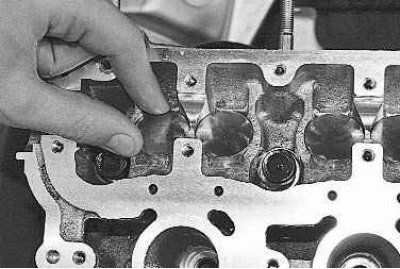
3. To check the hydraulic pusher, press it. If the hydraulic pusher is in good condition, it should sink in with considerable force, if this force is small, the hydraulic pusher is faulty. It is also necessary to check the ease of rotation of the hydraulic pusher in the socket of the block head. If the hydraulic pusher does not rotate or rotates with great effort, it must be replaced.
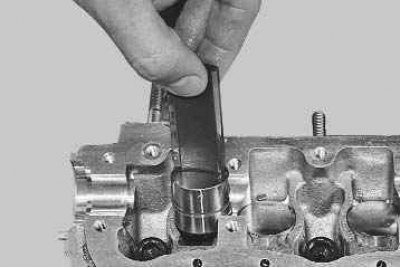
4. Remove the hydropusher from the socket of the cylinder head.
Note. Remove the hydraulic pusher with a conveniently sized magnet.
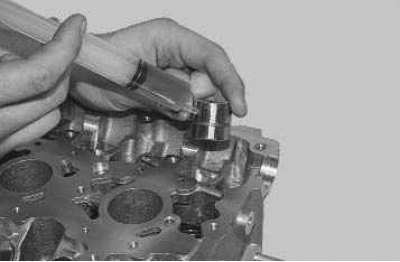
5. Lubricate the new hydraulic pusher and socket in the cylinder head with engine oil and install the hydraulic pusher into the socket.
6. The remaining hydraulic pushers are replaced in the same way.
7. Establish a camshaft and details of a drive of the gas-distributing mechanism in an order, the return to removal.
Note. After replacing the hydraulic pusher, the engine may run with increased noise for a short time at the first start-up until the hydraulic pushers are pumped. To speed up the pumping of the hydraulic pushers, let the engine run at an increased speed for 1–2 minutes.
